Why Was Your Flight Delayed?

There are few things more frustrating than packing your bags for a getaway or a trip home, only to find that the bulk of your “vacation” will be spent flipping through glossy magazines in a terminal full of screaming babies and sneezing snowbirds.
Unfortunately, flight delays and diversions are inevitable in life – just the same as death and taxes. And while winding up in an unexpected destination (or arriving a day or two later than expected) can be somewhat off-putting, there are several ways to better ensure you get where you need to go in a timely manner.
We studied the United States Department of Transportation’s most recent data and put together some stats regarding the most frequently delayed and diverted flights in America. If you do happen to get caught in the midst of a surprisingly extended layover, keep calm and remember – “All journeys have secret destinations of which the traveler is unaware.” Martin Buber said that, and we admire his optimism.
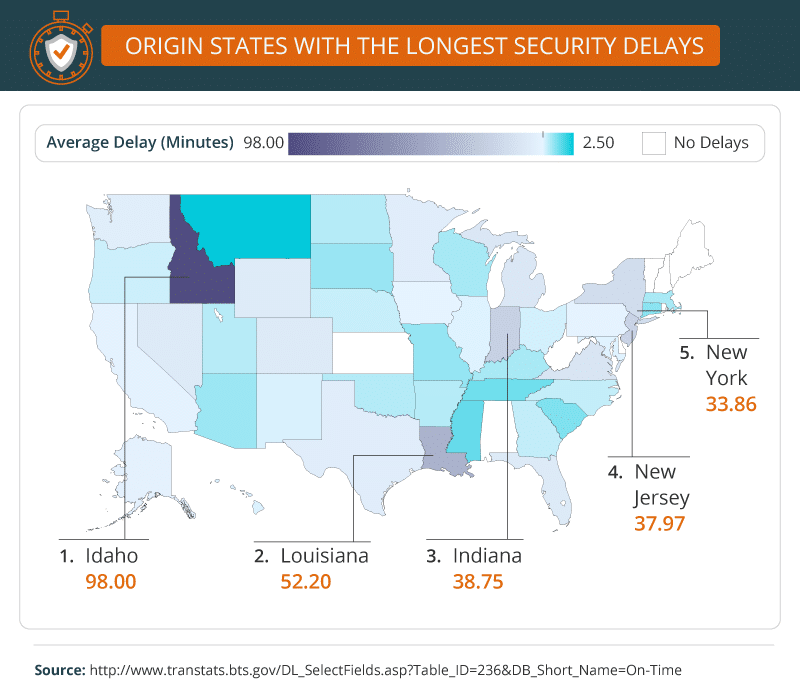
Security is a crucial component of safe flying. However, security delays can undeniably put quite a damper on expedient travel. Fortunately, the majority of states seem to experience relatively brief and tolerable flight delays based on security reasons. When it comes to how long a security issue stalls a flight, for most states it isn’t so bad at less than 30 minutes.
Flights departing from Idaho seem to experience the longest security-related delays, lasting an average of 98 minutes. Flights departing from Louisiana (52.2) and Indiana (38.75) also tend to experience some slight security delays, with New Jersey and New York ranking as well (37.97 and 33.86 minutes respectively). Security delays seem to pose very little threat to the timeliness of most national flights – well, as long as you steer clear of frequently departing from Idaho.
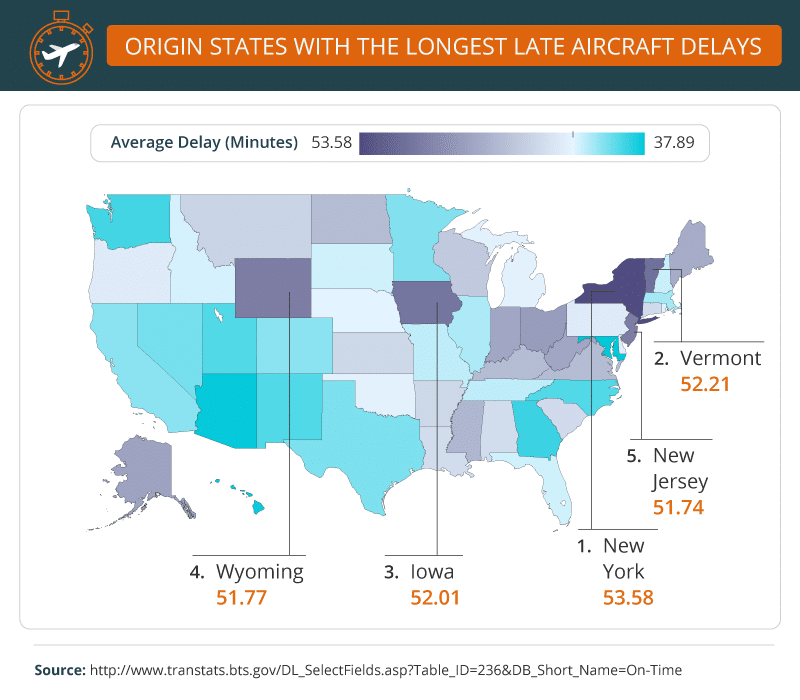
The Federal Aviation Administration considers a flight to be officially “delayed” when it takes off 15 minutes later than its scheduled time. Often a flight is delayed because the aircraft’s previous flight is late. In reality, 15 minutes seems relatively manageable – that’s about the amount of time it takes to buy a $5 bottle of water from the airport “convenience” store. The delays that occur in New York, Vermont, Iowa, Wyoming, and New Jersey, however, seem to last a bit longer than the standard 15 minutes.
When delayed due to the late arrival of an aircraft, flights departing from New York average a take-off time that is almost 54 minutes later than anticipated, while Vermont and Iowa departures are delayed an average of 52.21 and 52.01 respectively. Wyoming and New Jersey flights tend to leave just under 52 minutes behind schedule (51.77 and 51.74). No matter where your departing flight is leaving from, it might be wise to pack a smutty romance novel or install Candy Crush – you will likely be required to entertain yourself for at least a small chunk of time.
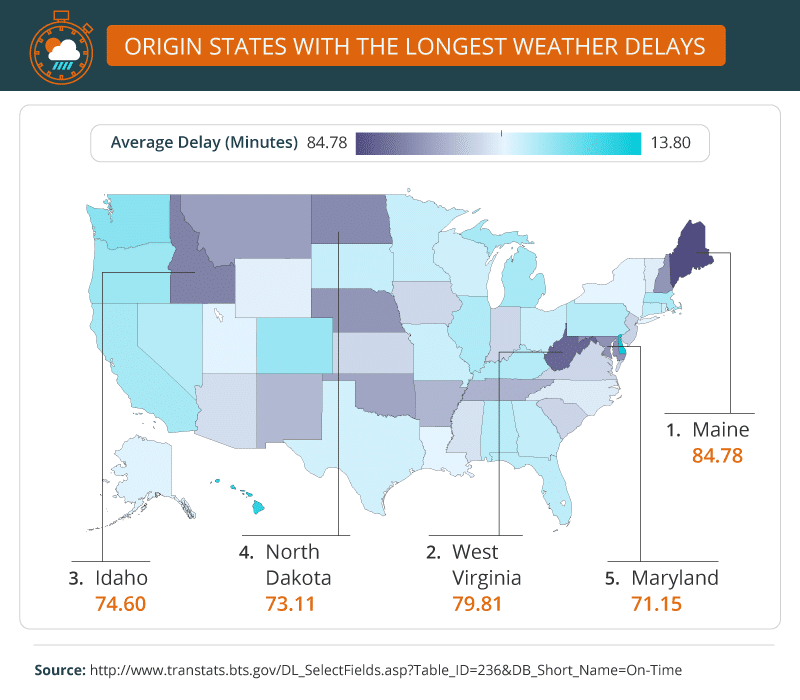
No one likes five minutes of unrelenting turbulence – but which is worse: finally utilizing those neatly tucked airsickness bags in lieu of an unsuspected snow storm or sitting on the hard terminal flooring amidst a pile of luggage and hastily wrapped holiday gifts for hours on end?
If you are attempting to fly out of Maine, West Virginia, Idaho, North Dakota, or Maryland between the months of January and February, you may want to pack a Snuggie and some pillows for your potentially extended terminal stay. Maine tops the weather-related delay chart with an average of roughly 84.78-minute-long setbacks. West Virginia experiences the second-most prolonged weather-related delays, with all delays averaging a total of 79.81 minutes. Those departing from Idaho, North Dakota, or Maryland should also plan on spending an extra hour or so in the airport – weather delays cause flights leaving from these states to take off between 74.60 and 71.15 minutes later than scheduled.

Sloulin Field International Airport (located in Williams County, North Dakota) to Houston George Bush Intercontinental Airport experiences the highest number of diverted routes by far, with 9.47% of all flights experiencing airport-to-airport diversions. Everything’s bigger in Texas, including the risk of prolonged route digressions apparently. Dallas/Fort Worth International to Aspen/Pitkin County Airport (located in Aspen, Colorado) experiences the second-highest number of diversions with a total of 8.16% of all flights undergoing some type of course interruption.
In fact, including the Dallas/Fort Worth route, Aspen/Pitkin makes an appearance in four of the top 10 destination states that experience the most frequently diverted routes: Los Angeles International to Aspen/Pitkin (6.86%), San Francisco International to Aspen/Pitkin (5.85%), and George Bush Intercontinental to Aspen/Pitkin (4.44%). Aspen/Pitkin also appears on the list of origin airports.
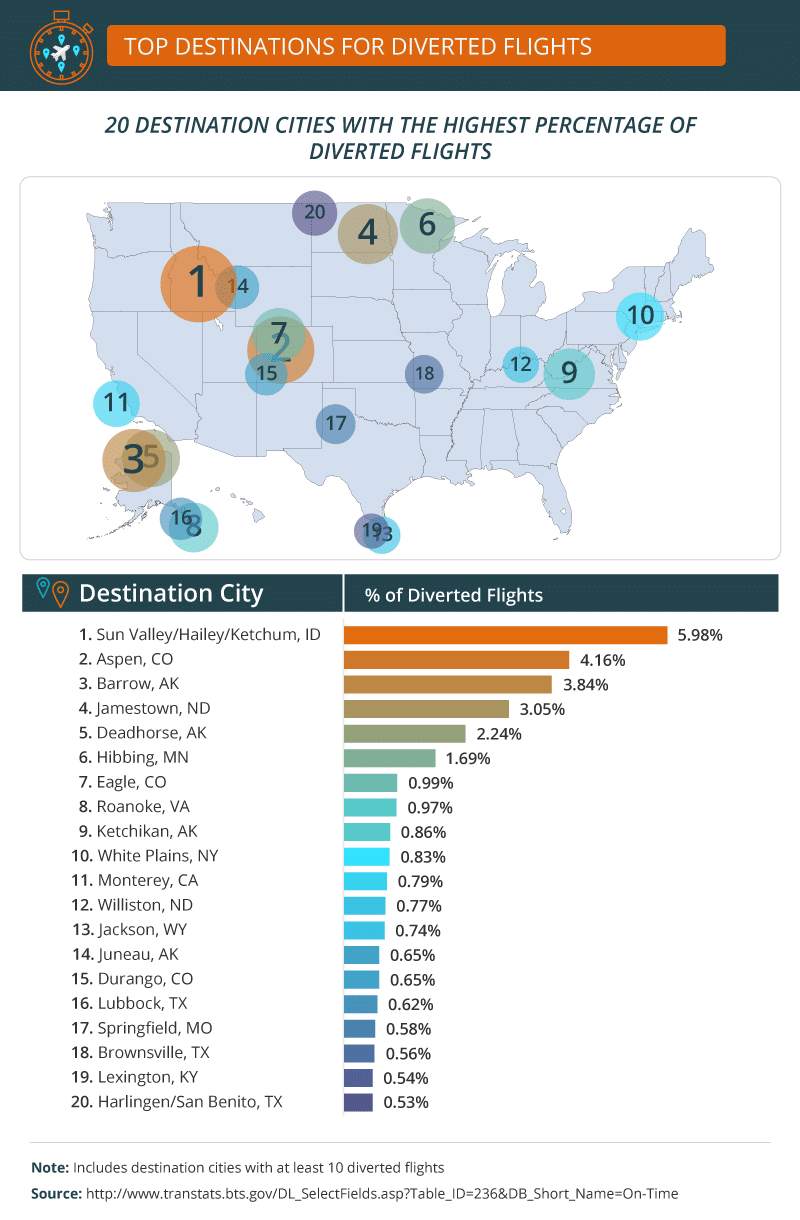
You fall asleep as your plane takes off LAX, looking forward to opening your eyes in several hours to the beautiful snowy mountains of Sun Valley, Idaho. However, there’s a chance (especially if you’re flying in the winter months) you’ll wake up to find yourself in a different destination entirely. But hey, life is about the journey anyway … right? This may be a good mentality to adopt if you’re planning on flying to Sun Valley/Ketchum/Hailey, Idaho – this area experiences a fair number of diversions; in fact, nearly 6% of all flights traveling here are diverted.
Many people on the way to Aspen, Colorado, also tend to end up elsewhere – 4.16% of all flights to Aspen are diverted somewhere along the way. Colorado destinations make the list twice more, with 0.99% of all flights to Eagle and 0.65% of all flights to Durango diverted as well. Alaska sees a fair amount of diversions too, with Barrow, Deadhorse, Ketchikan, and Juneau all making the top 20 most frequently diverted destinations list. Flights headed toward North Dakota, Minnesota, and Virginia are also often diverted – in fact, planes attempting to land in Jamestown, ND, are the fourth-most frequently diverted, with 3.046% of all travel plans delayed.
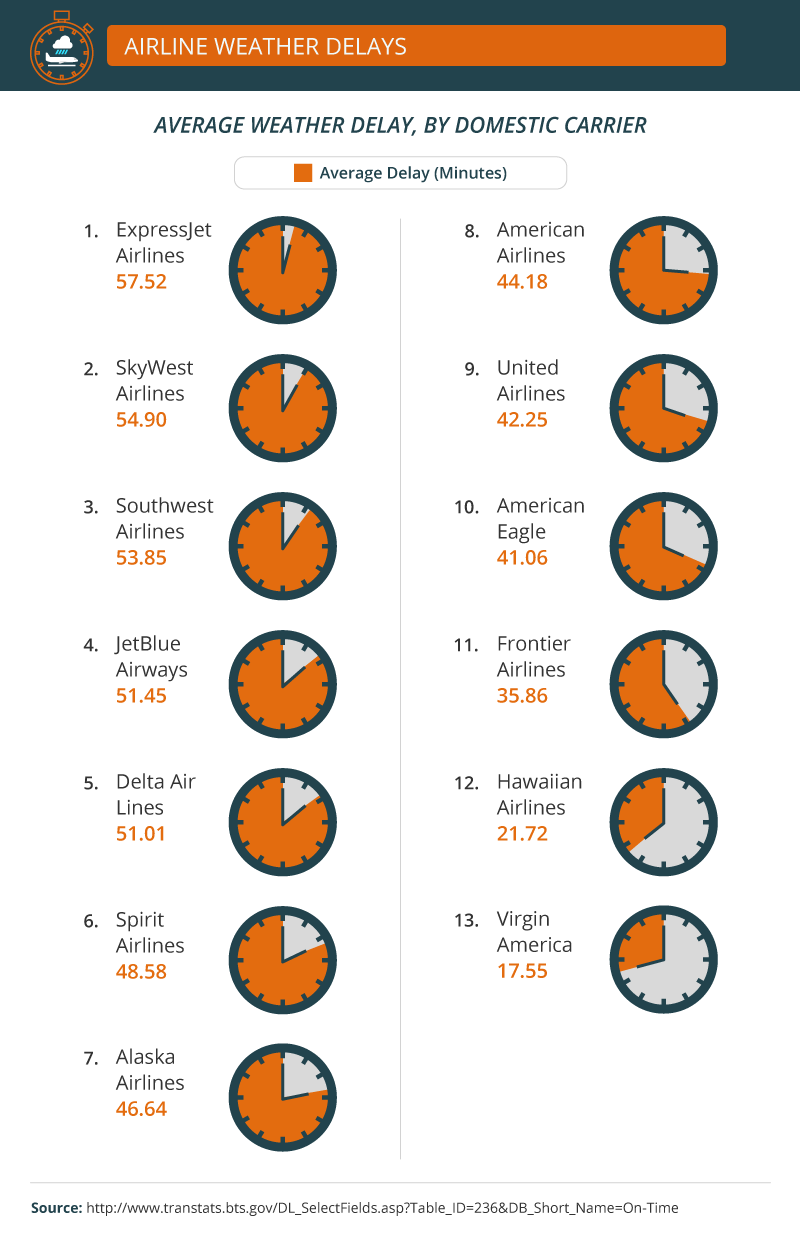
Weather patterns are unpredictable and entirely out of our control. As travelers, we often must accept the inevitable and put our travel plans on hold temporarily in light of a particularly bad blizzard or thunderstorm. Interestingly enough, certain airlines seem to experience significantly more weather delays than others. ExpressJet Airlines averages weather-related delays that last 57.52 minutes. SkyWest Airlines comes in second with delays lasting an average of 54.9 minutes. Southwest Airlines also experiences frequent weather delays, which last an average of 53.85 minutes. If you want to get somewhere on time (or an average of 17.55 minutes late, rather), try Virgin America – this domestic carrier experiences the shortest average delays, closely preceded by Hawaiian Airlines (21.72 minutes).
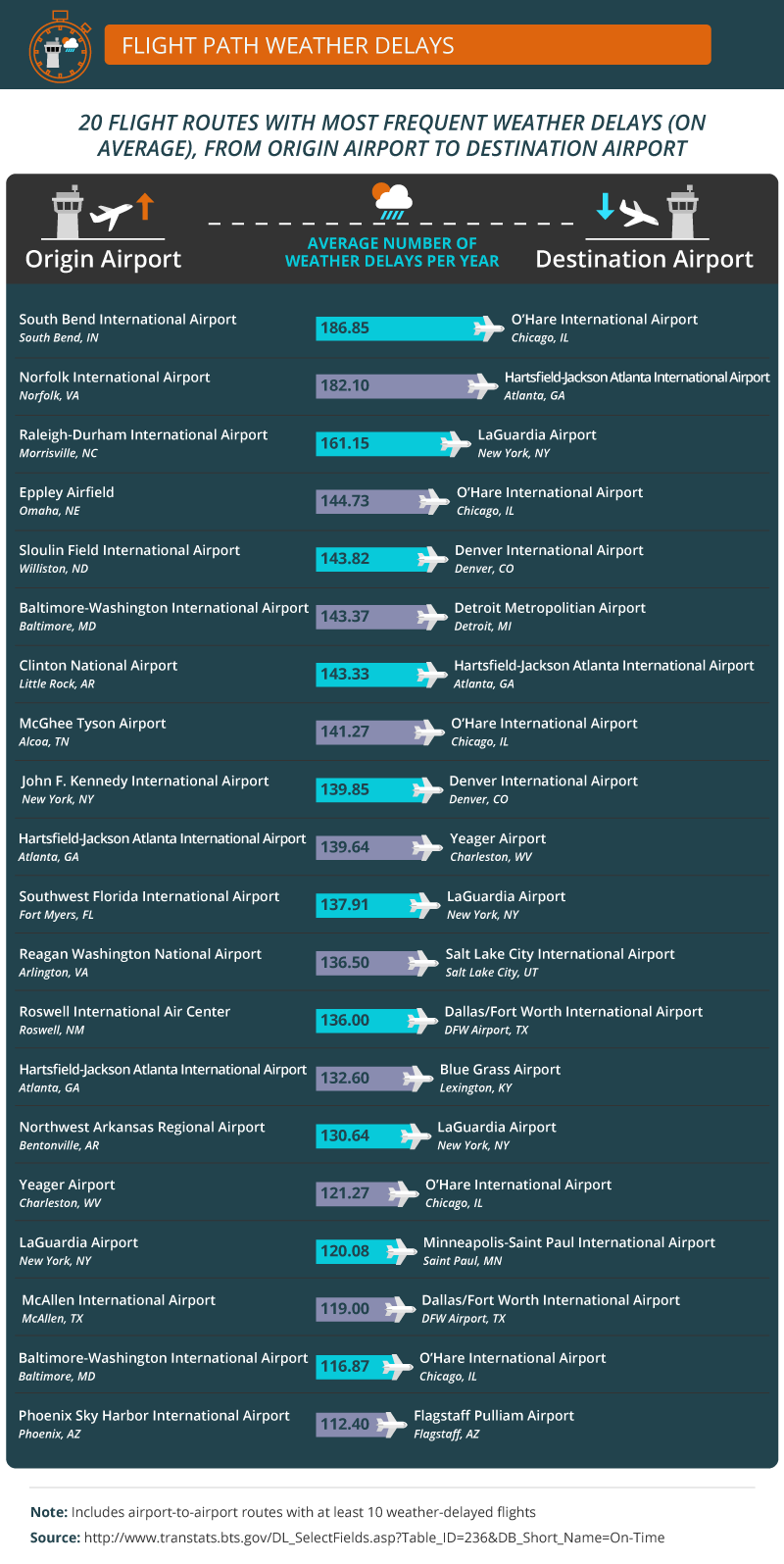
If you’re flying from South Bend International Airport to O’Hare International Airport, you may want to pack a book of crossword or Sudoku puzzles in your carry-on considering a slight weather delay is possible. Several flights to O’Hare International, including those departing from Eppley Airfield (in Omaha, NE), McGhee Tyson Airport (in Alcoa, TN), Yeager Airport (in Charleston, WV), and Baltimore-Washington International (in Baltimore, MD), experienced significant weather-related delays from January to September 2015. Flights from South Bend to Chicago topped the charts, with an average of 186.85 weather-related delays. Flights traveling to Hartsfield-Jackson Atlanta International Airport (from both Norfolk International Airport and Clinton National Airport) also experienced a fair number of weather delays.
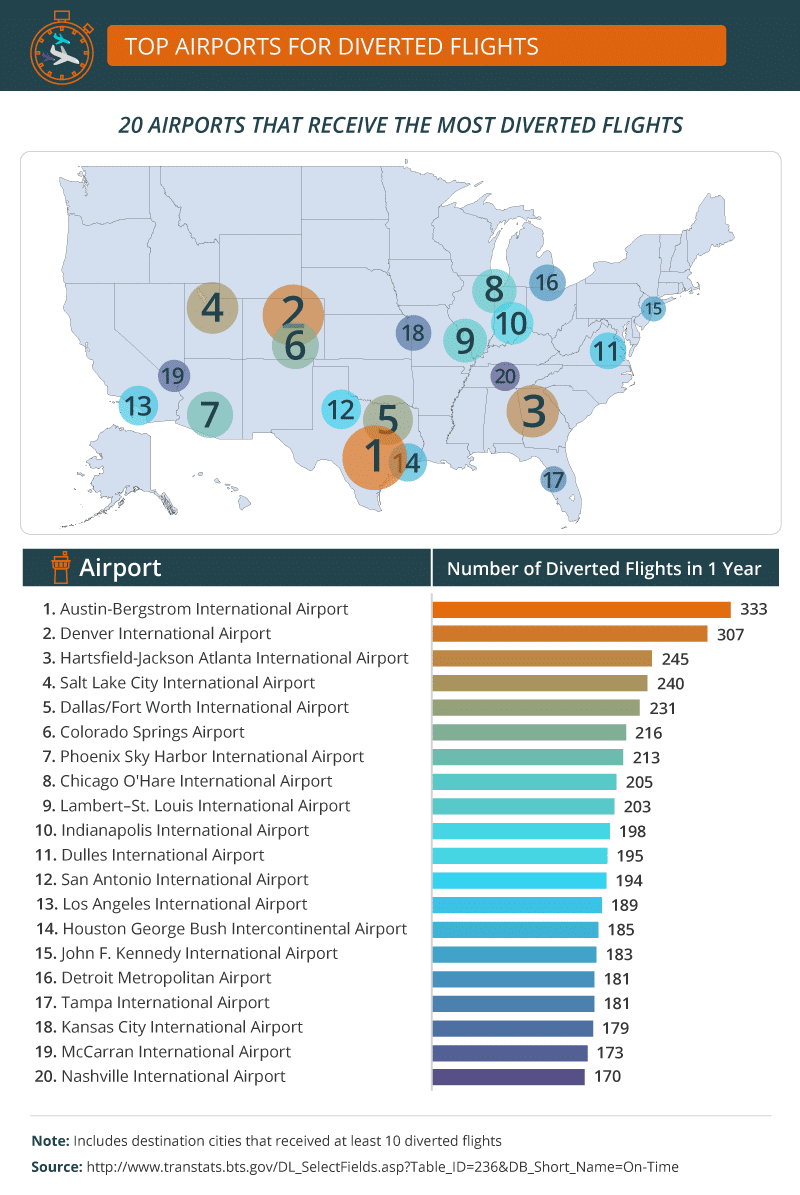
So where were all these flights diverted to? Some secret island off the coast of Alaska with thousands of glittering landing strips, all-you-can-eat crab leg buffets, and unlimited free Wi-Fi? No. Austin-Bergstrom International Airport in Austin, TX, apparently.This Texas airport saw a total of 333 diverted flights, followed closely by 307 unplanned landings at Denver International. Hartsfield-Jackson Atlanta International Airport, Salt Lake City International Airport, Dallas/Fort Worth International Airport, Colorado Springs Airport, Phoenix Sky Harbor International Airport, O’Hare International Airport, and Lambert-St. Louis International Airport all saw between 200 and 250 flight diversions this year.
CONCLUSION
Flight delays and diversions can be somewhat frustrating, especially for the traveler who gains more satisfaction from punctuality than browsing decorative neck pillows for hours at a time. While unpredicted weather patterns, security delays, and other potentially thwarting complications remain entirely out of your control, you can take several steps to ensure an enjoyable and relatively timely voyage.
If you haven’t got an hour to spare, try to fly out of an airport that experiences few diversions. Want to avoid delays altogether? Flying on a charter jet is a great way to avoid crowded airports and long waits – not to mention enjoying luxuries such as catered meals. And if it is too late or too inconvenient to alter your travel plans, don’t fret. The average of all delay times (regardless of cause) rarely ever exceeds an hour. Utilize that hour to catch up on reading, give the old business plan a once-over, or fall madly in love with that sweet Southern stranger sipping sweet tea at the in-terminal Ruby Tuesday. Hey – you never know.
METHODOLOGY
We analyzed over 3.9 million delayed flights from January until September 2015 using data from the Bureau of Transportation Statistics. We examined why and how long flights were delayed, which routes have the most diverted flights, and which airports receive them.
SOURCE
FAIR USE
Feel free to share all the images on this page. When doing so, please credit back to the authors by providing a link to this page and StratosJets.com so your readers can learn more about the methodology behind this project.









